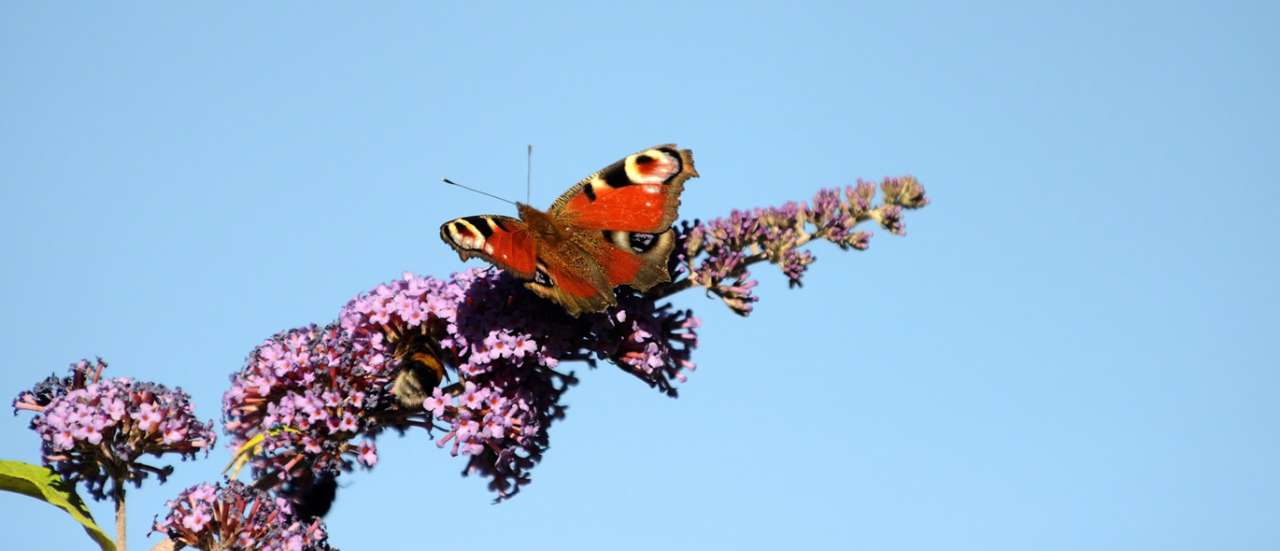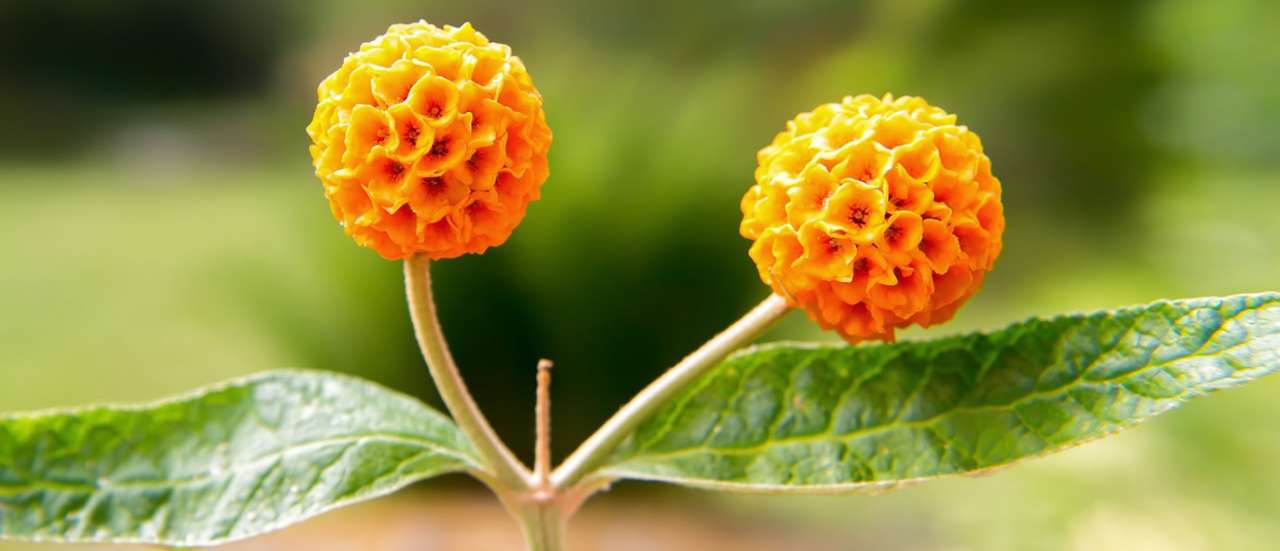Buddleja (or Buddleia) is commonly known as the "Butterfly Bush" for reasons that will become obvious if you have one in your garden. From mid-summer when these plants are usually in flower, butterflies will flock to their blooms hungry for their nectar. In Ireland, Peacock and Tortoise-shell butterflies seem to be particularly attracted to these flowering shrubs, which are essential for any gardener who loves to see these colourful critters flapping their delicate wings.
Buddleja are deciduous shrubs, and come in small varieties that are suitable for pots and borders, with other larger varieties that form sizeable shrubs and can even be grown and pruned to become a small flowering tree or standard. All buddleja are easy to maintain with just a few varieties that may need a more sheltered spot, so keep an eye on that when purchasing. On the whole, these shrubs are happy anywhere they can get a good dose of sunshine.
Most buddleja you will find in garden centres fall under the genus of Buddleja davidii, which are perfect for our cooler climate. Larger cultivars of Buddleja davidii reach up to 3m tall with dwarf cultivars like 'Buzz' or 'Nanho', and more recently the 'Butterfly Candy' series, only reach between 80cm and 1m tall. They generally come in colours of white and various shades of purple, pink and red with the variety Buddleja globosa being a standout, producing unusual spheres of yellow-orange flowers. Whatever your garden size, planting or colour scheme, there is bound to be a buddleja suitable for your outdoor space.

Where and How to grow:
Most buddleja available in Ireland will be perfectly suited to any garden that has a sunny spot, with moist but well draining soil, and are fully hardy in our climate. These will all tend to be cultivars of Buddleja davidii but can also fall under Buddleja alternifolia, x.weyeriana or the aformentioned globosa. In general, if the specific variety isn't stated it will be a davidii. Most varieties of buddleja will tolerate part or dappled shade but will be far more floriferous in full sun.
The hardy varieties of buddleja will also be fine with some exposure but try to avoid sites with extreme winds as the branches can become quite brittle and snap off. As with any plant purchase, always check the specifications and description so that you can find the right buddleja for your individual requirement.
Hardy buddlejas can be planted any time of year and you will find them on sale throughout the seasons both online and in store. Like most plants they are probably best planted in spring as the soil starts to warm up but as long as they are watered well, if planted in summer, these shrubs will become established pretty quickly at any time of year. If you do come across and purchase one of the less hardy varieties like Buddleja crispa or colvelei, these are definitely best planted in spring when any threat of frost has past and they will require winter protection.
For the planting itself:
- Dig a hole as deep as the pot they are in and two or three times as wide, digging some organic matter/compost into this area so that you'll have a nice rich soil around the plant when you backfill. This will give the shrub a great start and help it establish quickly. If you have heavy clay soil, you may also want to dig in a good handful or two of grit to improve drainage.
- Remove the plant from its pot, loosening any roots that may have become pot-bound (it's always good practice to give the pot a good watering an hour or so beforehand).
- Position the root-ball to the centre of the hole, making sure that the ground is level with the soil level in the pot – be sure not to plant the stem any deeper as this can cause rot as with any shrub. The roots will also benefit from a dusting of mycorrhizal fungi which will help the plants establish much quicker.
- Once positioned, you can then start to backfill the hole, gently firming the plant in with your heel, and give it a good watering.
Buddleja care:
Buddleja are very low maintenance and require little care other than a pruning once per year. Buddleja flower on new growth and so it is best to give them a hard prune in late spring, cutting back any dead wood to around 30cm above the ground, just above a bud or growing shoot where possible. You can cut to around 60 cm if you have a particularly large variety where you want the new growth to be more elevated. The only exception to this rule would be with varieties like globosa and alternifolia which flower on last seasons growth. These two should never be hard pruned but instead you can just cut out some of the oldest branches in mid summer to tidy the plant up.
Aside from that there is very little to do. In reasonably fertile soil, there is no real need to feed buddleja, just give them an annual mulch of compost or well rotted manure and ensure they are watered enough in the first 18 months whilst they establish. To be honest, with our climate, particularly in the West of Ireland, watering will only really be necessary if there is a particularly long dry spell or 'heatwave' in the summer otherwise they can be left to work away.
Propagation:
Buddleja are pretty easy to propagate from cuttings and will rarely fail. Softwood cuttings can be taken in mid-summer or hardwood cuttings in autumn and the method is the same for both:
- Cut of a non-flowering section of around 20-30 cm in length (depending on the size of the pot your are putting them in) and strip the stem, leaving only a couple of leaves at the top. If the leaves are particularly large you can cut them in half to minimise moisture evaporation from the leaves.
- At the base the cutting should be cut just below a bud and you can dip the base in some hormone rooting powder if you want to increase chances of success even further. Several of such cuttings can be put in a pot of loose compost, making sure around 2/3 of the cutting is under the soil. Water the pot and keep the soil moist but not overly wet as you don't want the cuttings to rot.
- You can even cover the pot with a polythene bag but try not to have the plastic touching any leaves - even better if you can just cut the base off a suitably sized plastic bottle and place the top over the whole pot, this will allow you to unscrew the bottle top and allow excess moisture out as it condenses in the bottle. These can then be kept somewhere shaded until they develop.
You should see root development in a few weeks (just check the bottom of the pot to see if any roots are coming through) at which point you can pot these on. It's advised you continue to pot on over the course of the next year or two so you have a good sized shrub to plant out in your garden.
Buddleja Companions
Buddleja are pretty versitile in the garden but as with any shrub, you will need companions that suit similar growing conditions. They look great planted amongst other shrubs but there are some perennials that we think pair particularly well:
- Nepeta
Pretty much all varieties of catmint look great planted around buddleja and their silvery foliage complements that of the buddleja perfectly. The purple, pink or white flowers (depending on the variety) of nepeta matched with any of the white, purple or pink shades offered by the buddleja provide a lovely calming effect in the garden. - Salvias
Similarly, the foliage and flower colour of salvias also pair well with buddlejas and taller growing varieties do well to hide the woody stems of the butterfly bush if that's something you are looking for. - Sedums
Autumn flowering stonecrop plants can provide great ground cover around a buddleja and have a cooling effect on the buddleja roots, with flowers that provide even more nectar for butterflies.
Overall buddlejas are a great addition to your outdoor space both for you and our much loved pollinators. We have a range of buddleja shrubs available throughout the year so why not check out our range online or pop into one of our stores in Boyle or Roscommon town to find the perfect Butterfly Bush for you.









